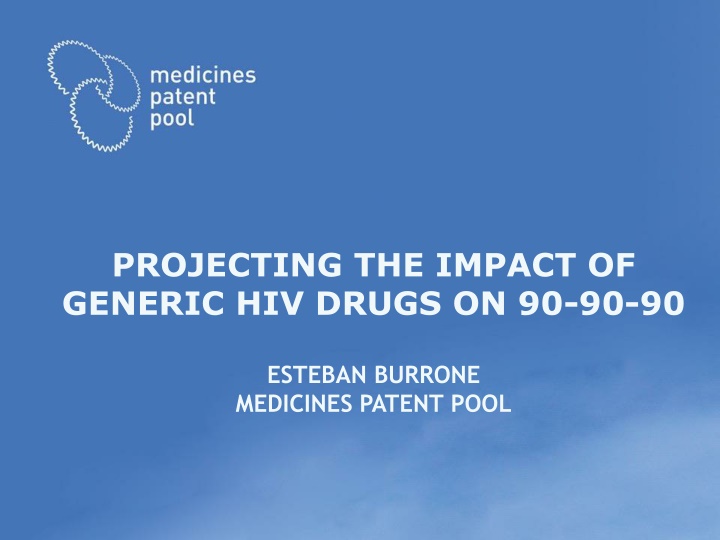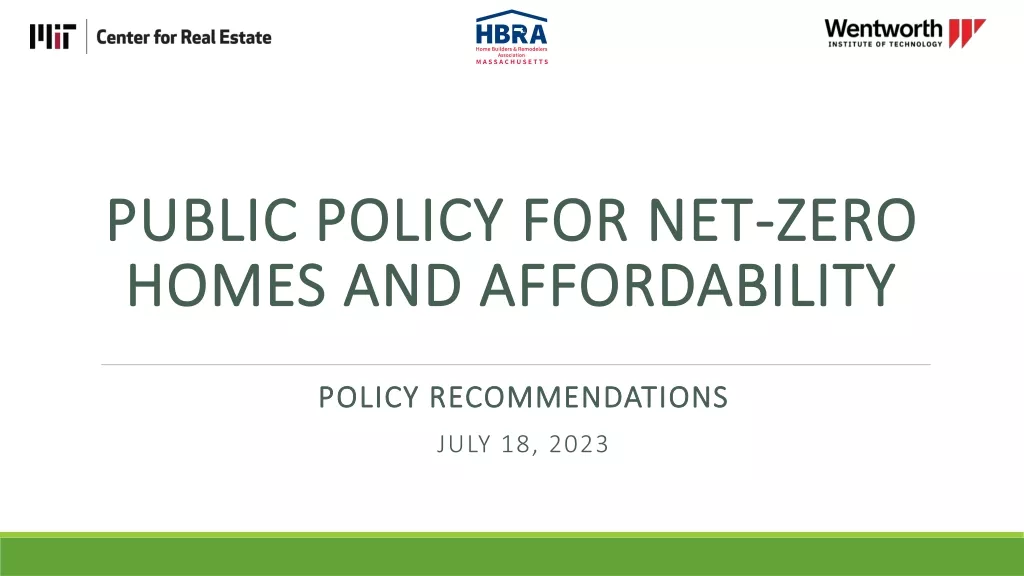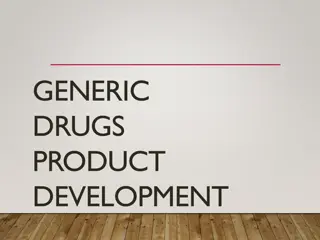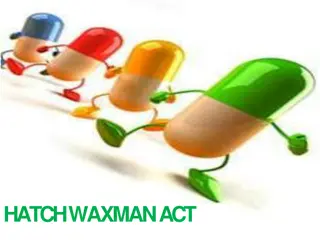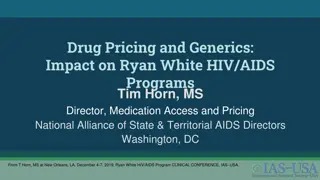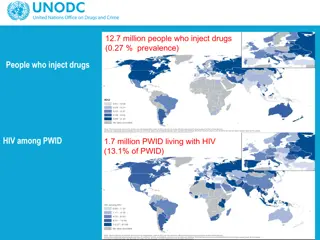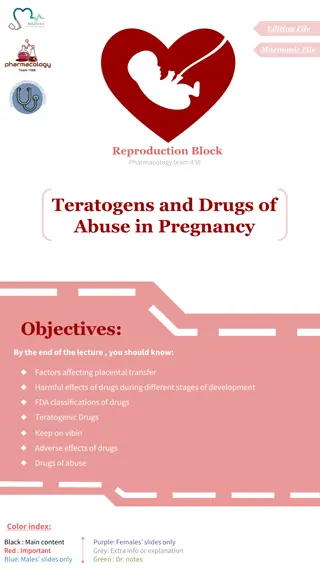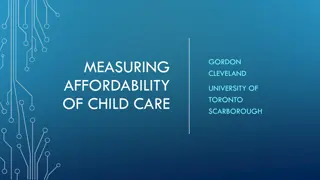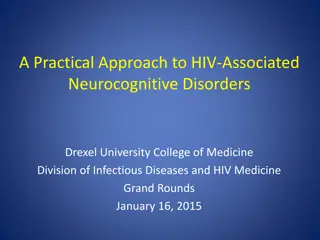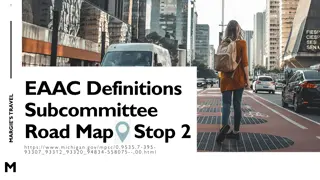Impact of Generic HIV Drugs on HIV Treatment Affordability and Innovation
Innovation in HIV treatment has led to the development of over 30 new antiretrovirals (ARVs) since 1983. Generic competition has played a significant role in lowering ARV prices, making treatment more affordable and accessible. Access-oriented licensing has enabled generic manufacturers to produce quality-assured treatments, contributing to treatment scale-up globally.
Download Presentation

Please find below an Image/Link to download the presentation.
The content on the website is provided AS IS for your information and personal use only. It may not be sold, licensed, or shared on other websites without obtaining consent from the author.If you encounter any issues during the download, it is possible that the publisher has removed the file from their server.
You are allowed to download the files provided on this website for personal or commercial use, subject to the condition that they are used lawfully. All files are the property of their respective owners.
The content on the website is provided AS IS for your information and personal use only. It may not be sold, licensed, or shared on other websites without obtaining consent from the author.
E N D
Presentation Transcript
PROJECTING THE IMPACT OF GENERIC HIV DRUGS ON 90-90-90 ESTEBAN BURRONE MEDICINES PATENT POOL
CONTENTS 1. Impact in terms of treatment affordability 2. Impact in making new treatments available faster 3. Impact in making needed new formulations
INNOVATION IN HIV TREATMENT HIV treatment has witnessed innovation on a major scale Over 30 new antiretrovirals (ARVs) developed for the treatment of HIV since 1983 Several fixed dose combinations developed that contain 3 or 4 ARVs in one single pill New medicines under development, including new mechanisms of action, new delivery systems, long acting formulations, implants, monoclonal antibodies, etc.
IMPACT IN TERMS OF TREATMENT AFFORDABILITY
FUNDING TO PROCURE ARVS Today: 21.7 million people on treatment worldwide of which at least 19 million people in low and middle-income countries (based on UNAIDS data ) At approximately USD 85 per patient per year for 1stline (WHO GPRM; Global Fund) * Spending on ARVs in LMICs is estimated at approximately USD 2 billion * Some countries procure at higher prices and 2nd and 3rd line ARVS are more expensive
FUNDING TO PROCURE TREATMENT Without generic manufacturers (hypothetical): Scenario 1: at US$ 10,439 per patient per year* (lowest originator price in year 2000): we would need US$ 198 billion to procure medicines for the same number of people in LMICs Scenario 2: at US$ 613 per patient per year* (lowest originator price in 2017): we would need US$ 11.6 billion to procure medicines for the same number of people in LMICs or if we only have USD 2 billion we would only be able to procure ARVs for approximately 3.3 million people in LMICs * MSF, Untangling the Web (2010) and MSF, HIV & Opportunistic Infection Treatment: Spotlight On Access Gaps (2017)
ACCESS ORIENTED LICENSING TO ENABLE GENERIC COMPETITION Many factors contributed to large price reductions for ARVs through generic competition enabling treatment scale up (donor funding, strong activism, development of national programs, political will, patent laws, generic manufacturers ability to make quality-assured treatments, etc.) One key mechanism has been access oriented licensing which has increasingly become the norm in HIV Access-oriented licences are agreements with the patent holders that allow multiple manufacturers to make generic versions of patented medicines and supply large number of LMICs.
THE MEDICINES PATENT POOL: A PUBLIC HEALTH ORGANIZATION ENGAGED IN ACCESS ORIENTED LICENSING PEOPLE NEEDING ACCESS TO MEDICINES IN DEVELOPING COUNTRIES PATENT HOLDERS GENERIC MANUFACTURERS Sub- Licences Licences Medicines ROYALTIES The MPP is funded by
MPP LICENCES GEOGRAPHICAL COVERAGE (BASED ON WORLD BANK CLASSIFICATIONS) Product(s) Licensed Abacavir (paed.) Atazanavir Bictegravir Cobicistat Daclatasvir Dolutegravir (paed.) Dolutegravir Elvitegravir Lopinavir/Ritonavir (paed.) Lopinavir/Ritonavir (Africa) Raltegravir (paed.) Ravidasvir Sutezolid (global) TDF TAF LIC LMIC UMIC HIC Undefined Total 31 53 31 5 1 121 + 31 52 32 3 3 122 + 30 48 25 9 4 116 30 48 25 9 4 116 31 46 30 2 3 112 + 31 53 31 5 1 121 + 31 53 6 2 0 92 + 30 42 17 8 3 100 31 50 19 2 0 102 26 17 10 2 2 57 + 31 50 9 2 0 92 1 9 9 - - 19 # 31 53 56 78 0 218 30 48 25 9 4 116 30 48 25 9 4 116 + Additional countries may be able to procure generics # Complements DNDi licence for a total of over 130 countries
PARTNERSHIPS WITH INNOVATORS Lopinavir Solid dispersion Nevirapine (non- Ritonavir Atazanavir nanotechnology assert) (seperate licences- Daclatasvir (HCV) for HIV adults and paediatrics) Bictegravir Cobicistat Elvitegravir Emtricitabine Tenofovir Alafenamide Tenofovir Disoproxil Valganciclovir Raltegravir Darunavir (peadiatric (pricing (peadiatric) non-assert) agreement) Abacavir ( paediatric) Dolutegravir Sutezolid (TB) Ravidasvir (HCV) Darunavir related (peadiatric) Dolutegravir (adults)
IMPACT ON 90-90-90 More affordable treatments contribute to the second 90, enabling more people to access treatment with available resources
IMPACT IN MAKING NEW TREATMENTS ACCESSIBLE FASTER IN LMICS
IN THE PAST LONG DELAYS FOR UPTAKE OF NEW MEDICINES IN LOW AND MIDDLE INCOME COUNTRIES The Case of Tenofovir (TDF) 250 30 tab packs TLE/TEE pa (millions) 200 150 GF PRs 100 50 Volumes 0 2000 2001 2002 2003 2004 2005 2006 2007 2008 2009 2010 2011 2012 2013 2014 10-11 Years from Approval to Scale-up Scale-up of Tenofovir in Low and Middle Income Countries Approval of Tenofovir in US Source: GF PPM/PQR data. 2014 for part year;
THE CASE OF DOLUTEGRAVIR (DTG) 4 years from originator approval to availability from multiple suppliers in a new fixed dose combination ( TLD ) at affordable prices August 2013: DTG approved by US FDA Sept 2017 Price of USD 75 announced for DTG combination June 2016 WHO guidelines recommend DTG in 1st line 2017 2016 2015 2014 2013 August 2017: First approval of new combination (TLD) from MPP licensee November 2016: First MPP licensees filed for WHO Prequalification April 2014: MPP license with ViiV Healthcare
IMPACT IN MAKING NEEDED NEW FORMULATIONS
ADULT FIXED DOSE COMBINATIONS Case of Tenofovir/lamivudine/dolutegravir (TLD) Dolutegravir has higher barrier to resistance than current first line with efavirenz (SPRING trial) It is better tolerated, with fewer treatment discontinuations TDF: enables treatment for hepatitis B in co-infected people and no need for HLA-B*5701 screening Potential for lower price than efavirenz combination Caution regarding potential safety signal for women with HIV at time of conception (issue to be further discussed at IAS) http://www.who.int/medicines/publications/drugalerts/Stateme nt_on_DTG_18May_2018final.pdf
TDF/3TC/DTG (TENOFOVIR DISOPROXIL/LAMIVUDINE/DOLUTEGRAVIR) 13 MPP licensees are currently developing TDF/3TC/DTG, of which: 6 have filed with WHO-PQ 7 have filed with USFDA; of which two have received approvals 4 companies have received approval by the WHO/Global Fund Expert Review Panel In all, 2 generic versions of TLD are already in the market and an additional 4 are expected to be launched soon
TDF/3TC/DTG: Country-wise Filing Status Filed (25) Approved (6) (69.2% PLHIV in LMICs) (19.4% PLHIV in LMICs) Benin Ghana South Africa Botswana Burkina Faso Madagascar Tanzania C te d'Ivoire Burundi Mali Uganda India Cameroon Mozambique Ukraine Kenya Congo Namibia Vietnam Malawi DR Congo Niger Zambia Uzbekistan Nigeria Zimbabwe El Salvador Ethiopia Rwanda Gabon Senegal Generic TLD has been filed in 31 countries, of which approval is received from 6 Another 25 filings are planned for 2018
Paediatric formulations LPV/r (sprinkles in sachet or minitabs in capsule) Three companies working on this product: 1. One company has received USFDA approval 2. Another has filed with WHO-PQ and USFDA in Q1-18 3. The third plans to file with USFDA and WHO-PQ in Q3-19 LPV/r/ABC/3TC (sprinkles in sachet or minitabs in capsule) Three companies working on this product: 1. One plans to file with USFDA and WHO-PQ in Dec-18 2. Another plans to file with USFDA and WHO-PQ in 2019 3. Another developing, filing status and plans unknown Three companies working on the product Filing plans in 2019 ABC/3TC/EFV Multiple companies interested in development, awaiting WHO recommendation on dosage ABC/3TC/DTG
IMPACT ON 90-90-90 Faster access to new optimized ARVs and development of needed adult and paediatric formulations contributes to the third 90, through access to optimized formulations that are better tolerated, lower treatment discontinuations, higher resistance barrier
The MPPs HIV, TB and hepatitis C activities are fully funded by:
THANK YOU www.medicinespatentpool.org www.medspal.org @MedsPatentPool
